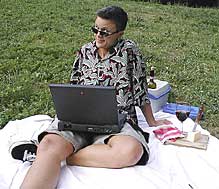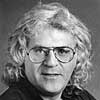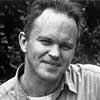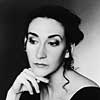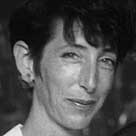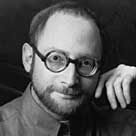
Joseph Dalton
Photo by Dorothy Alexander |
|
Collecting composers’ autographs used to be a hobby of mine. In my youth it was an early indicator of my future profession. It also got me to attend (and sometimes to endure) all manner of musical happenings, and allowed me to meet some wonderful figures, some of whom are now gone. Ironically, as I attend more and more concerts, year after year, the memorable ones are fewer and rarer. There are more great performances and more great pieces, but fewer unusual occasions.
This fascination with composers began during my high school years. I was active in Catholic church music and when attending conferences on “pastoral music” I’d always ask the composers to autograph the photo-copied song sheets. That was in Texas in the 1970s. During the early 1980s, I attended college in Washington, DC (Catholic University of America) where I began my avid following of contemporary music. While this interest made me an oddity at the Music School, the Capital offered a rather active new music scene to explore. I remember meeting and getting autographs from numerous composers at the Kennedy Center’s American Composers Series, which was held in its intimate Terrace Theatre. There I heard Feldman’s For John Cage (at the time a real test of patience and fortitude) and I hummed along in participatory pieces by Pauline Oliveros. I also met John Cage and seemed to catch his fancy at a 70th birthday concert in his honor held in the great hall of the historic Pension Building. I went behind the band shell on the Capital Lawn to meet Morton Gould who had just conducted the National Symphony. At all of these occasions, the composers happily autographed my concert programs, though Morton Gould made do with the lid from a box of Wheat Thins. The most memorable and stirring concert experience of my life was at the dawn of my life in music — just days before I began classes as a freshman music major. It was in September 1981 and the Kennedy Center was opening a tenth-anniversary production of Leonard Bernstein’s Mass (which was the Center’s opening piece ten-years prior).
I received a call in my dorm room from my one relative in Washington, Hope Ridings Miller, who was a distant and much older cousin and who once edited the society page of the Washington Post and was part of the capital’s social scene since the days of Roosevelt. She told me that she had two tickets to the opening night performance of Bernstein’s Mass and that she had seen it the first time and once was enough! “How would you and a friend like to go see the show and meet Leonard Bernstein afterward?” Needless to say, that was an opportunity not to be missed.
To this eighteen year old who was about to begin music school the following week, Mass was a revelation. In less than two-hours it gave me my first exposure to a world of new styles and techniques including serialism, spatial music, electronics, simultaneity, and collage, all in addition to the beautiful soaring melodies and driving dance rhythms of Bernstein at his best. I didn’t know the names for all those things I was hearing and I also didn’t know that composers weren’t supposed to mix and match them all in once piece. Such a wonderful stew of sounds! Likewise the staging was an introduction to non-linear theatre and modern dance. From the marching band that processed down the aisles in the Kyrie to when the cast goes mad in the cathartic and climactic Agnus Dei, practically every barrier of musical and theatrical propriety was broken down. And to hear that it was controversial and made some people angry made me love it all the more! There was also an element of glamour with all the black-tie and evening gowns and the piece’s association with the Kennedys.
That night I brought along my roommate, Joe Walsh, who was a piano-performance major. (I was a music ed major and my instrument was voice.) Though the evening required black-tie, we’d not yet purchased concert wear and so we had to wear dark suits. When we arrived at theTerrace for the reception, not only were we improperly dressed but our names were not on the guest list. Joe was ready to leave but I was not to be denied. I was already getting familiar with Washington-ways having spent the prior semester as a Congressional Page on Capital Hill. Among the many things I learned from 5 months in the halls of Congress was how to slip through door ways and into the rooms of power. After finally being allowed into the reception, much to my roommates astonishment, we found some dreary old people and unappealing food tables. Where was Bernstein?
My image of Lenny was of a dashing figure with a mop of dark hair. Joe rolled his eyes (as he often did that year at my many musical naiveté’s) and said that Bernstein had aged since those days. We did get a look at him as he took a bow from the stage, but when he finally entered the party space, it was his aura, more than his looks, that made it clear he was the celebrity of the evening.
Before describing my actual meeting with Bernstein, I have to digress again into my musical education. At that time, I was already studying voice with one of the University’s professors, Mildred Allen, and I had a lesson on the morning of the big opening night. I arrived at her studio already full of excitement about the upcoming evening. “And we might get to meet Bernstein!” I exclaimed. “Isn’t that nice,” she replied. “Now sing a chest Ahh.” A few exercises later, Mrs. Allen added: “If you do meet Bernstein, be sure to tell him hello.” I gulped and nodded. (It was only some years later that I learned more fully of Mrs. Allen’s career. She had sung at the Met and worked with a few composers over the years including singing on the legendary Columbia recording of Stravinsky’s Les Noces.)
That night on the Kennedy Center Terrace, I stepped up to Bernstein boldly, my roommate sheepishly following behind. I introduced us as freshman music majors and Lenny acknowledged us with a glance and scribbled his autograph on our librettos. I raised my voice to add: “And I’m a student of Mildred Allen and she said to tell you hello.” Boom. I had his attention! He looked me in the eyes and asked my name which I gladly repeated. He then pinched my cheek with a hand that seemed to encompass half my face. Whatever may have been on Lenny’s mind at that moment, I considered it a benediction from the high priest of American music and I’ve carried the flame ever since!
I met Bernstein a few more times during my early years in New York, thanks to opportunities provided by my employment (from 1987 to 1989) at CBS Masterworks. To my great pride, the first time album credit I ever received was on a Bernstein release, The Bernstein Songbook, which I helped to program and which was CBS’s best selling Bernstein title during his 70th birthday year (1988). A framed and autographed copy of the LP jacket now proudly hangs in my office at CRI. Almost everything about Lenny remains special to me, but his Mass still makes me think of that night when my innocence, musical and otherwise, allowed me to experience him and his music with a rare sense of joy and wonder.


